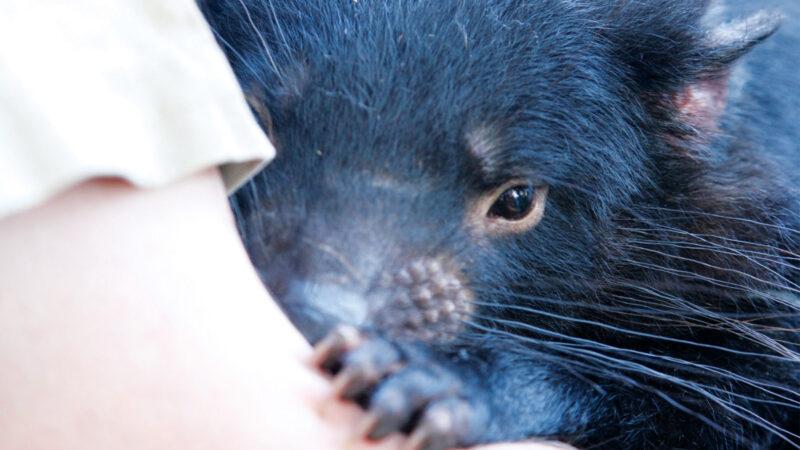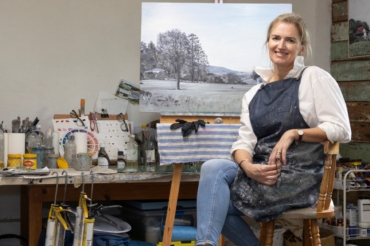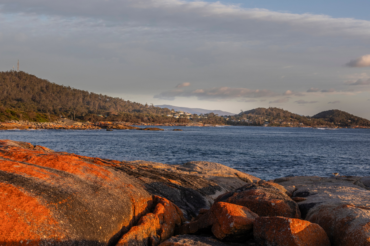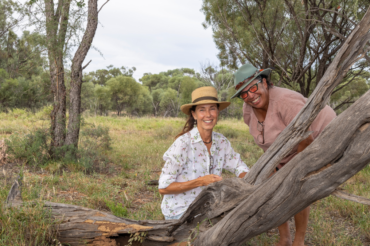
A road trip across the top of Tasmania provides plenty of opportunities to sample fine hospitality and produce, see spectacular natural scenery and blow away a few cobwebs.
It’s gusting 50 kilometres per hour at Cape Grim on the very north-western extremity of Northern Tasmania, but guide Laura Dabner assures everyone that’s barely a breeze in these parts. Winds of up to 160kph are not unheard of as the Roaring 40s crash into the coastline after blowing westerly between latitudes 40°S and 50°S. They have plenty of time to gain momentum as they’re uninterrupted by land for almost 20,000km across the Southern Ocean from the Patagonian coast of South America.
As Laura wryly observes, this explains why most residents in this neck of the woods have very tidy backyards. It also means it’s a great location for the Woolnorth Wind Farm, with a total of 62 turbines producing 10 per cent of the island state’s power. The turbines Laura is discussing stand between 60 metres tall with blades 32m long, the same size as the wing of a Boeing 747. But these towers are small fry compared with the latest turbines measuring 120m tall with 66m blades. And it’s official: the Cape Grim Baseline Air Pollution Station, which has been monitoring the air quality since 1976, consistently reports that Cape Grim has the cleanest air on the planet.

Laura runs Woolnorth Tours, which is the sole tour operator providing access to wild and windy Cape Grim and the vast Woolnorth station, owned by the Van Diemen’s Land Company since it was established in 1826 to produce wool for mills in the UK.
Laura took over the tour business in 2015 from her mother, Helen Schuuring, who had run it for 12 years before that, so there’s not much she doesn’t know about the area. As a proud Aboriginal descendant, that insight includes encyclopaedic knowledge of the local landscape, flora and fauna and a good measure of European and Aboriginal history. Not all of it is pretty, but it does provide an exceptional opportunity to shoot the breeze.
George Bass and Matthew Flinders named Cape Grim during their circumnavigation of Van Diemen’s Land in 1798, a voyage that proved that what later became known as Tasmania was an island. Woolnorth Station was an early grant of 250,000 acres (101,171 hectares) of farming land. It was ruled by the Van Diemen’s Land Company’s chief agent from a massive convict-built homestead (Highfield Historic Site) perched on a hill above Stanley, 78km to the east.
The region was too wet for sheep but that didn’t stop successive owners trying for almost 180 years. They finally gave up in 2002 and these days most of the viable land is devoted to dairying. The north-western corner of Northern Tasmania now produces 35 per cent of Australia’s milk, while a portion of it is also celebrated for raising Cape Grim Beef.
Morning tea on Laura’s tour is served in the vast shearing shed, which stands like a monument to the failed wool-growing ambitions. The break is an opportunity for Laura to share details of a sorry story from the property’s past. In 1828, the Cape Grim massacre resulted in the shooting of about 30 Aboriginal people, who were ambushed by the station workers while gathering food on the beach. Some of their bodies were subsequently disposed of by throwing them off a 60m cliff. This violent and reprehensible act was “justified” as a reprisal raid for an earlier Aboriginal attack on a flock of sheep. That in turn was payback for the European farmhands’ abduction and rape of a group of young Aboriginal women. It’s a chapter that has not been much discussed until recently but, like much of Australian history, deserves wider exposure on the path to reconciliation.

On a more cheerful note, Laura mentions that there’s an “insurance population” of Tasmanian devils on the property. Tassie’s iconic animal emblem is listed as endangered and at risk of extinction in the wild, due to facial tumour disease, which impedes the stocky marsupial’s ability to eat until it dies of starvation. This plight is compounded by the fact that Tassie devils are scavengers, so many are killed by cars while they are feasting on roadkill left on the roads at night. “This is why it’s important to observe the road-safety warning signs and slow down when driving at night,” Laura explains.
“If you do hit an animal, it’s advisable to remove the carcass from the road, so the devils aren’t exposed to
the risk of becoming carrion themselves.”
Due to the remote location, the Woolnorth devils are so far disease-free, and these days conservation programs manage them by feeding them culled wallabies. The local population is currently estimated to be around 2000 but, as devils are nocturnal, it’s rare see one in the wild. If you do manage an encounter, treat them with respect. Thanks to their large head and wide-opening jaws, devils have the most powerful bite of any mammal carnivore. Those jaws are designed to crunch through bone and generate sufficient force to bite through thick metal wire.
Driving east (very carefully) from this informative interlude, there’s time for a stop at Tarkine Fresh Oysters, where Jon Poke and his family have been growing oysters in the clear waters of Duck Bay for more than 40 years.
It takes two and a half years to grow an oyster from seed to buffet size and at the shop at the front of the processing sheds, Laura Poke explains that they sell 500-dozen oysters a week to a passing parade of locals and visitors. Freshly shucked oysters are the main drawcard, but the Pokes also offer a range of snap-frozen dressed oysters including Kilpatrick, mornay, and bacon and sweet chilli ready for the oven.
Nearby at Duck River Meadows Dairy, Venezuelan couple Rosselyn and Genaro Velasquez have formed a bright new future for themselves and their two kids making cheese from their home country and Europe under the label, La Cantara. They trained as vets in their former lives and moved to Tasmania to work in the dairy industry. Now they offer tours with tastings most days of the week.

Other reasons to explore Stanley include Marley’s Cafe, the Angel’s Share where you can sample some of Tasmania’s boutique spirits and produce, and the Stanley Hotel, which has been serving customers continuously since it was opened by a convict made good in 1847.
It’s only 20km further on to Stanley, a historic village that’s dominated by The Nut, the remains of a volcanic plug that juts out into the ocean. Visitors can walk or take a chairlift to the top of this landmark. The beautifully preserved buildings are another reason to linger in town, which so resembles a Cornish fishing village that you wouldn’t be surprised if you ran into Doc Martin doing his grumpy rounds. The harbour is dominated by the Hersey family’s red fishing fleet and down by the water a giant red lobster, or crayfish as they are more accurately known, sits on the roof of their seafood restaurant. The Hersey family has been fishing in Tasmanian waters for four generations, and current patriarch Mark Hersey now runs the business with his two sons. Their fleet of eight boats brings in the daily catch of striped trumpeter, gummy shark, scallops, abalone and, of course, crayfish. The Herseys are justly proud that their restaurant only serves line-caught fish and they are able to offer crayfish year-round thanks to holding tanks that ensure supply when the season is closed.
Our rooms for the night are at the Ship Inn, a charming boutique hotel recently restored by Kerry and Alistair Houston. They’ve created an oasis of calm in the suites and apartments, each stocked with breakfast provisions of sourdough bread, preserves, muesli, poached fruit and yoghurt. A talented stonemason and landscape designer, Alistair has created a truly magnificent garden in the lee of The Nut out the back, and you could be tempted, as one artist did, to book in for a residency and paint endless views of the captivating surrounds. You can read more about the Houstons and the bond store they have turned into a residence in our next issue.

It’s 55km from Stanley to Table Cape, a beacon on the north coast map, and not just for the lighthouse, which is one of only two on the mainland of the state that’s open to the public. Table Cape is home to the Roberts-Thomson family’s tulip farm and from late September until the end of October each year, they open their gates so visitors can walk through the avenues of colour provided by hectares of flowering blooms.
Other don’t-miss landmarks in this region include Table House accommodation run by Alan and Wendy Page, whose story starts on page 80 of this issue, and Alchymia Distillery, where Sarah and Matt Packwood-Hollings have turned their back on corporate lives to make single-malt whisky, gin and vodka as sustainably as possible in a former farm shed.
It’s about half an hour’s drive from there to Burnie, home to the Emu Valley Rhododendron Garden, an 11-hectare showcase for the spring-flowering genus and its companion plants. The garden, which is run by volunteers, has been developed over 40 years and displays more than 24,000 different rhododendrons divided by their country of origin. If gardens are your thing, take a detour to Kaydale Lodge gardens at Nietta, where sisters Amarlie and Lesley Crowden continue the work their parents, Kay and Robert, began almost 50 years ago when they moved to a farm as newlyweds. They’ve built almost two hectares of grounds and hundreds of metres of stone walls in what was originally a bare paddock with lots of rocks.
The Leven Canyon, a 250m ravine in the wilderness is nearby and its lookout is easily accessible via a 20-minute bushwalk. Backtrack to the coast via Ulverstone with a pit stop at the Thirty Three Cups cafe, which offers an innovative menu that’s accommodating for most dietaries. From there, it’s about an hour’s drive inland to Deloraine, an artsy town on the Meander River and great base for exploring the Great Western Tiers and Liffey Falls, as well as the nearby Christmas Hills Raspberry Farm and Ashgrove Cheese Dairy Door. Check out the quirky wares at the Brush Rabbit store, grab a meal at Cycles restaurant in the Empire Hotel or maybe spend the night in the ensuited pub rooms upstairs.

Launceston, located in Northern Tasmania, is just 50km to the north-east, one of only two Australian cities to enjoy the status of UNESCO City of Gastronomy (Bendigo is the other) and home to restaurants including Stillwater, Mudbar, Black Cow as well as Bread + Butter Bakery and Sweetbrew cafe. Most visitors make their way to Design Tasmania, where Tassie talent is showcased along with a collection of finely crafted timber objects. Cataract Gorge can be explored by foot, cruise boat or via a chairlift that gives passengers a bird’s-eye view of the wilderness that’s preserved just 15 minutes’ walk from the CBD.
Lonnie, as the locals dub it, is also the gateway to the wineries of the Tamar Valley and a good base for visiting cellar doors including Velo Wines, Pipers Brook, Janz and Josef Chromy. If you’re visiting during summer, drop by Bridestowe Lavender Estate for Insta-worthy shots in the fields of lavender and internationally renowned ice-cream. Golfers will be sure to take in Barnbougle, one of Australia’s most highly rated courses, while bushwalkers will forge on to Mount William National Park, where the options include the 11km summit walk, the more leisurely Cobblers Rocks walk or luxurious guided walks including Wukalina and the Bay of Fires treks.
On the edge of the park, Eddystone Point marks the northern-most point of the Bay of Fires, which was named by English navigator Tobias Furneaux in 1773 when he saw fires lit by the Aboriginal inhabitants burning onshore. The bay stretches for about 50km down to Binalong Bay and from there it’s 175km back to Launceston. But before you go, pause for a day or a week to take in this spectacle of the north-eastern edge of the state. The serene vistas of orange lichen-covered granite boulders framing the whitest sand and azure ocean could not be a greater contrast to the wild and rugged north-western edge. But that’s Tasmania for you: an addictive amalgam of the wild and wonderful, creature comforts and challenges.
Photography by Ken Brass









